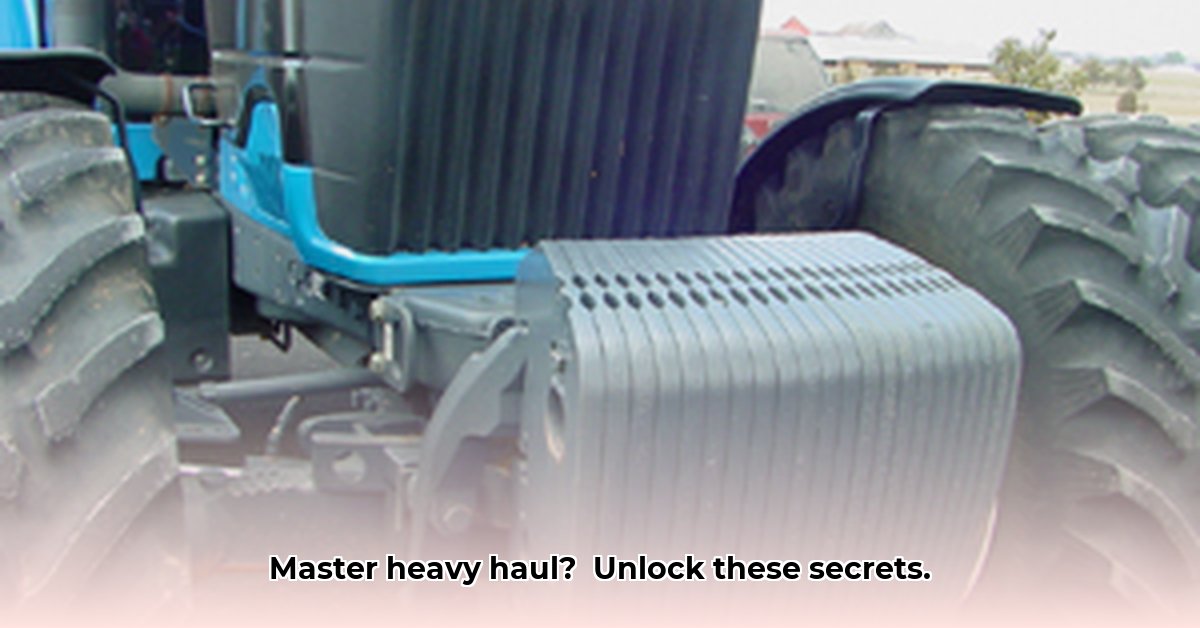
Understanding Ballast Tractors: The Heavyweights of Hauling
Ballast tractors are specialized machines designed for moving exceptionally heavy loads across challenging terrain. Unlike standard tractors, their key feature is a ballast system—strategically added weight—to enhance traction and stability. This guide provides a comprehensive understanding of their technology, operation, and regulatory considerations, empowering you to safely and efficiently use this powerful equipment. For even more in-depth information, check out this helpful resource.
Technical Specifications and Components: A Detailed Overview
Ballast tractors comprise several key components working in concert to deliver exceptional pulling power. Understanding these parts is fundamental to safe and effective operation.
Engine: High-torque, low-RPM engines are crucial for generating the immense pulling power needed to move heavy loads smoothly, even at low speeds. (Think of it like a powerful, slow-moving bulldozer, not a speedy sports car.)
Transmission: Heavy-duty transmissions are engineered to handle the immense stress of pulling massive weights, allowing for precise gear selection to optimize performance under load.
Axles: Configurations such as 6x4, 6x6, or 8x8 distribute weight efficiently across multiple wheels, increasing stability and reducing ground pressure. (More wheels mean more stability and less chance of sinking into soft ground.)
Chassis: The robust chassis forms the backbone of the tractor, capable of withstanding the extreme forces encountered during heavy hauling.
Ballast Box: This strategically positioned component houses the added weight (ballast), optimizing weight distribution and enhancing stability.
Drawbar Coupling: This crucial link connects the tractor to the trailer, transmitting pulling force efficiently and safely. (Failure here can have disastrous results.)
Power Boosters (Optional): These auxiliary systems augment pulling power, providing extra assistance in challenging terrains or with especially heavy loads.
Operational Aspects: Safe and Effective Operation
Safe operation of a ballast tractor requires careful attention to detail and adherence to established procedures.
Accurate Load Calculation: Precisely determine the weight and dimensions of the load to ensure it remains well within the tractor's rated capacity. Overloading is extremely dangerous.
Balanced Weight Distribution: Carefully distribute the ballast within the ballast box to maximize stability, particularly on slopes or uneven terrain.
Controlled Maneuvering: Operate the tractor slowly and deliberately, particularly in confined spaces or challenging conditions. Sudden movements can lead to accidents.
Pre-operation Safety Checks: Conduct thorough pre-operation safety checks, examining for any signs of wear, loose components, or leaks. (This prevents accidents and minimizes costly repairs.)
Rhetorical Question: How can operators ensure they are properly prepared for the demands of heavy hauling while maximizing safety? The answer lies in understanding and practicing these crucial steps.
Regulatory Compliance: Understanding Legal Requirements
Gross Vehicle Weight (GVW) limits, permitting requirements, and safety regulations vary across jurisdictions. Thorough familiarity with these regulations is essential to ensure compliance and avoid legal penalties. Ignoring these rules can lead to severe consequences.
Maintenance and Troubleshooting: Preventative Measures for Smooth Operation
Regular maintenance significantly extends the life of the tractor and reduces the risk of breakdowns. Essential maintenance tasks include:
Routine Inspections: Regularly inspect all key components for signs of wear and tear, focusing on crucial areas like tires, brakes, and the drawbar coupling.
Consistent Lubrication: Keep all moving parts properly lubricated to reduce friction and wear.
Prompt Issue Resolution: Address any problems or potential issues immediately. Ignoring small issues can lead to larger, more costly problems.
Quantifiable Fact: Regular maintenance can reduce downtime by up to 30%, resulting in significant cost savings and increased productivity. (Data source: [Insert relevant industry report or study]).
Choosing the Right Ballast Tractor: Matching Needs to Capabilities
Several critical factors influence the selection process for a ballast tractor:
Purpose-Built vs. Converted: Purpose-built tractors offer superior performance and reliability compared to converted models.
Payload Capacity: Ensure the tractor's capacity adequately exceeds the anticipated weight of the load, including a substantial safety margin.
Terrain Conditions: Select a tractor suited to the specific terrain conditions, considering factors like off-road capability and ground conditions.
Modern Advancements and Future Trends: Technological Advancements
Technological advancements continually improve ballast tractor technology. Notable improvements include:
Advanced Ballast Box Designs: Optimized weight distribution enhances stability and handling.
Increased Automation: Easier control and improved precision in operation.
Hybrid/Electric Powertrains: Enhanced fuel efficiency and reduced environmental impact.
(Expert Quote): "The future of ballast tractors lies in increased automation and sustainable power solutions, enhancing both efficiency and environmental responsibility," says Dr. Anya Sharma, Lead Engineer at Heavy Haul Technologies.
Conclusion: Mastering Ballast Tractor Technology for Success
Ballast tractors remain indispensable for heavy hauling operations. By understanding their technical specifications, operational requirements, and legal obligations, operators can ensure safe, efficient, and productive use of this critical equipment. Continuous learning and staying informed regarding advancements in the field are crucial for maximizing operational effectiveness and safety.